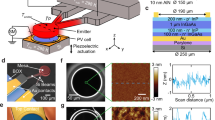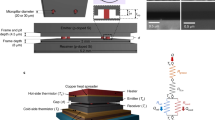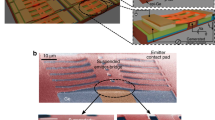Abstract
Conversion of heat to electricity via solid-state devices is of great interest and has led to intense research of thermoelectric materials1,2. Alternative approaches for solid-state heat-to-electricity conversion include thermophotovoltaic (TPV) systems where photons from a hot emitter traverse a vacuum gap and are absorbed by a photovoltaic (PV) cell to generate electrical power. In principle, such systems may also achieve higher efficiencies and offer more versatility in use. However, the typical temperature of the hot emitter remains too low (<1,000 K) to achieve a sufficient photon flux to the PV cell, limiting practical applications. Theoretical proposals3,4,5,6,7,8,9,10,11,12 suggest that near-field (NF) effects13,14,15,16,17,18 that arise in nanoscale gaps may be leveraged to increase the photon flux to the PV cell and significantly enhance the power output. Here, we describe functional NFTPV devices consisting of a microfabricated system and a custom-built nanopositioner and demonstrate an ~40-fold enhancement in the power output at nominally 60 nm gaps relative to the far field. We systematically characterize this enhancement over a range of gap sizes and emitter temperatures, and for PV cells with two different bandgap energies. We anticipate that this technology, once optimized, will be viable for waste heat recovery applications.
This is a preview of subscription content, access via your institution
Access options
Access Nature and 54 other Nature Portfolio journals
Get Nature+, our best-value online-access subscription
$29.99 / 30 days
cancel any time
Subscribe to this journal
Receive 12 print issues and online access
$259.00 per year
only $21.58 per issue
Buy this article
- Purchase on Springer Link
- Instant access to full article PDF
Prices may be subject to local taxes which are calculated during checkout




Similar content being viewed by others
References
He, J. & Tritt, T. M. Advances in thermoelectric materials research: looking back and moving forward. Science 357, 1369–1377 (2017).
Snyder, G. J. & Toberer, E. S. Complex thermoelectric materials. Nat. Mater. 7, 105–114 (2008).
Whale, M. D. & Cravalho, E. G. Modeling and performance of microscale thermophotovoltaic energy conversion devices. IEEE Trans. Energy Conver. 17, 130–142 (2002).
Narayanaswamy, A. & Chen, G. Surface modes for near field thermophotovoltaics. Appl. Phys. Lett. 82, 3544–3546 (2003).
Laroche, M., Carminati, R. & Greffet, J. J. Near-field thermophotovoltaic energy conversion. J. Appl. Phys. 100, 063704 (2006).
Basu, S., Chen, Y. B. & Zhang, Z. M. Microscale radiation in thermophotovoltaic devices—a review. Int. J. Energ. Res. 31, 689–716 (2007).
Park, K., Basu, S., King, W. P. & Zhang, Z. M. Performance analysis of near-field thermophotovoltaic devices considering absorption distribution. J. Quant. Spectrosc. Rad. 109, 305–316 (2008).
Bright, T. J., Wang, L. P. & Zhang, Z. M. Performance of near-field thermophotovoltaic cells enhanced with a backside reflector. J. Heat Transfer 136, 062701 (2014).
Tong, J. K., Hsu, W. C., Huang, Y., Boriskina, S. V. & Chen, G. Thin-film ‘thermal well’ emitters and absorbers for high-efficiency thermophotovoltaics. Sci. Rep. 5, 10661 (2015).
Chen, K. F., Santhanam, P. & Fan, S. H. Suppressing sub-bandgap phonon-polariton heat transfer in near-field thermophotovoltaic devices for waste heat recovery. Appl. Phys. Lett. 107, 091106 (2015).
Lau, J. Z. J. & Wong, B. T. Thermal energy conversion using near-field thermophotovoltaic device composed of a thin-film tungsten radiator and a thin-film silicon cell. J. Appl. Phys. 122, 084302 (2017).
Zhao, B. et al. High-performance near-field thermophotovoltaics for waste heat recovery. Nano Energy 41, 344–350 (2017).
Polder, D. & Van Hove, M. Theory of radiative heat transfer between closely spaced bodies. Phys. Rev. B 4, 3303–3314 (1971).
Pendry, J. B. Radiative exchange of heat between nanostructures. J. Phys. Condens. Matter 11, 6621–6633 (1999).
Joulain, K., Mulet, J. P., Marquier, F., Carminati, R. & Greffet, J. J. Surface electromagnetic waves thermally excited: radiative heat transfer, coherence properties and Casimir forces revisited in the near field. Surf. Sci. Rep. 57, 59–112 (2005).
Basu, S., Zhang, Z. M. & Fu, C. J. Review of near-field thermal radiation and its application to energy conversion. Int. J. Energ. Res. 33, 1203–1232 (2009).
Song, B., Fiorino, A., Meyhofer, E. & Reddy, P. Near-field radiative thermal transport: from theory to experiment. AIP Adv. 5, 053503 (2015).
Molesky, S. & Jacob, Z. Ideal near-field thermophotovoltaic cells. Phys. Rev. B 91, 205435 (2015).
Modest, M. F. Radiative Heat Transfer 3rd edn (Academic Press, Oxford, UK, 2013).
Song, B. et al. Radiative heat conductances between dielectric and metallic parallel plates with nanoscale gaps. Nat. Nanotech. 11, 509–514 (2016).
DiMatteo, R. S. et al. Enhanced photogeneration of carriers in a semiconductor via coupling across a nonisothermal nanoscale vacuum gap. Appl. Phys. Lett. 79, 1894–1896 (2001).
DiMatteo, R. et al. Micron-gap ThermoPhotoVoltaics (MTPV). AIP Conf. Proc. 738, 42–51 (2004).
Ganjeh, Y. et al. A platform to parallelize planar surfaces and control their spatial separation with nanometer resolution. Rev. Sci. Instrum. 83, 105101 (2012).
Song, B. et al. Enhancement of near-field radiative heat transfer using polar dielectric thin films. Nat. Nanotech. 10, 253–258 (2015).
Whittaker, D. M. & Culshaw, I. S. Scattering-matrix treatment of patterned multilayer photonic structures. Phys. Rev. B 60, 2610–2618 (1999).
Yeh, P. Optical Waves in Layered Media (Wiley, New York, 1988).
Francoeur, M., Menguc, M. P. & Vaillon, R. Solution of near-field thermal radiation in one-dimensional layered media using dyadic Green’s functions and the scattering matrix method. J. Quant. Spectrosc. Rad. 110, 2002–2018 (2009).
Zhu, L. & Fan, S. Near-complete violation of detailed balance in thermal radiation. Phys. Rev. B 90, 220301 (2014).
St-Gelais, R., Zhu, L., Fan, S. & Lipson, M. Near-field radiative heat transfer between parallel structures in the deep subwavelength regime. Nat. Nanotech. 11, 515–519 (2016).
Lenert, A. et al. A nanophotonic solar thermophotovoltaic device. Nat. Nanotech. 9, 126–130 (2014).
Guler, U., Boltasseva, A. & Shalaev, V. M. Refractory plasmonics. Science 344, 263–264 (2014).
Acknowledgements
P.R. and E.M. acknowledge support from the Army Research Office under awards W911NF-16-1-0195 and W911NF-18-1-0004 (nanopositing and instrumentation), from the Department of Energy-Basic Energy Science under award DE-SC0004871 (scanning probes and experimental design) and the National Science Foundation under award CBET 1509691 (computational modelling). We acknowledge the Lurie Nanofabrication Facility for facilitating the fabrication of devices.
Author information
Authors and Affiliations
Contributions
P.R. and E.M. conceived and supervised the work. A.F. and L.Z. performed the experiments and calculations, and D.T. and R.M. fabricated the emitter devices. The manuscript was written by A.F., P.R. and E.M. with comments and input from all authors.
Corresponding authors
Ethics declarations
Competing interests
The authors declare no competing interests.
Additional information
Publisher’s note: Springer Nature remains neutral with regard to jurisdictional claims in published maps and institutional affiliations.
Supplementary information
Supplementary Information
Supplementary Figures 1–10
Rights and permissions
About this article
Cite this article
Fiorino, A., Zhu, L., Thompson, D. et al. Nanogap near-field thermophotovoltaics. Nature Nanotech 13, 806–811 (2018). https://doi.org/10.1038/s41565-018-0172-5
Received:
Accepted:
Published:
Issue Date:
DOI: https://doi.org/10.1038/s41565-018-0172-5
This article is cited by
-
All electromagnetic scattering bodies are matrix-valued oscillators
Nature Communications (2023)
-
Whole-infrared-band camouflage with dual-band radiative heat dissipation
Light: Science & Applications (2023)
-
Night-time radiative warming using the atmosphere
Light: Science & Applications (2023)
-
Resonant Thermal Transport Driven by Surface Phonon-Polaritons in a Cylindrical Cavity
International Journal of Thermophysics (2023)
-
Novel data on genotoxic assessment of bismuth sulfide nanoflowers in common carp Cyprinus carpio
Environmental Monitoring and Assessment (2023)



